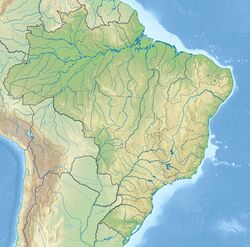Earth:Bauru Group
| Bauru Group Stratigraphic range: Late Cretaceous (Coniacian-Maastrichtian) ~89–66 Ma | |
|---|---|
| Type | Group |
| Unit of | Bauru Sub-basin |
| Sub-units | Araçatuba, Adamantina, Uberaba, Marília, Vale do Rio do Peixe, Cambambe, São José do Rio Preto & Presidente Prudente Formations |
| Underlies | Alluvium |
| Overlies | Caiuá Group |
| Lithology | |
| Primary | Sandstone |
| Other | Conglomerate, siltstone, mudstone, coal |
| Location | |
| Coordinates | [ ⚑ ] : 19°42′S 48°00′W / 19.7°S 48.0°W |
| Paleocoordinates | [ ⚑ ] 24°24′S 29°12′W / 24.4°S 29.2°W |
| Region | Minas Gerais, São Paulo, General Salgado, Itapecuru-Mirim, Mato Grosso |
| Country | |
| Extent | Paraná Basin |
| Type section | |
| Named for | Bauru |
The Bauru Group is a geological group of the Bauru Sub-basin, Paraná Basin in Minas Gerais, São Paulo, General Salgado, Itapecuru-Mirim, Mato Grosso, Brazil whose strata date back to the Late Cretaceous. Dinosaur remains are among the fossils that have been recovered from the formation.[1]
Subdivisions
According to a 2016 study:[2]
The Bauru Basin covers an area of approximately 379.362 km2 located almost exclusively in Brazil.., with selected outcrops in Northeastern Paraguay (Fúlfaro, 1996). This Cretaceous sedimentary succession reflects changing nonmarine environments, such as eolian, lacustrine, fluvial and alluvial fans.
The Bauru Group was divided by Fernandes and Coimbra (1996) in four formations, namely Adamantina, Uberaba, Araçatuba and Marília.[3] In 1998, Fernandes revised the group and recognize six formations, Uberaba, Vale do Rio do Peixe, Araçatuba, São José do Rio Preto, Presidente Prudente and Marília.[4] The Adamantina Formation was divided in Vale do Rio do Peixe, São José do Rio Preto and Presidente Prudente Formations.[4]
Vertebrate paleofauna
Molluscan paleofauna
Gastropoda
- †Physa aridi Mezzalira, 1974[5]
- †Physa mezzalirai Ghilardi, Carbonaro & Simone, 2011[6]
- †Viviparus souzai Mezzalira, 1974[5]
Bivalvia
- †Anodontites freitasi Mezzalira, 1974[5]
- †Anodontites pricei Mezzalira, 1974[5]
- †Diplodon arrudai Mezzalira, 1974[5]
- †Florenceia peiropolensis Mezzalira, 1974[5]
- †Itaimbea priscus (Ihering, 1913)[5]
- †Monocondylaea cominatoi Mezzalira, 1974[5]
- †Sancticarolis tolentinoi Mezzalira, 1974[5]
- †Taxodontites paulistanensis (Mezzalira, 1974)[5]
See also
- List of dinosaur-bearing rock formations
- Areado Group of the São Francisco Basin
- Santana Group of the Araripe Basin
References
- ↑ Weishampel, David B. (2004). "Dinosaur distribution (Late Cretaceous, South America)". in Weishampel, David B.; Dodson, Peter; Osmólska, Halszka. The Dinosauria (2nd ed.). University of California Press. pp. 600–604. ISBN 0-520-24209-2.
- ↑ Costa Menegazzoa, Mirian; Catuneanu, Octavian; Chang, Hung Kiang (2016). "The South American retroarc foreland system: The development of the Bauru Basin in the back-bulge province". Marine and Petroleum Geology 73: 131–156. doi:10.1016/j.marpetgeo.2016.02.027. https://doi.org/10.1016/j.marpetgeo.2016.02.027. Retrieved November 28, 2021. "The fossil record indicates that sediment accumulated from the Cenomanian to early Paleocene, beginning after the Mochica Phase of the Andean orogeny.".
- ↑ Fernandes, L.A.; Coimbra, A.M.A (1996). "Bacia Bauru (Cretáceo Superior, Brasil)". Anais da Academia Brasileira de Ciências 68 (2): 195–205.
- ↑ 4.0 4.1 Fernandes, L.A.; Coimbra, A.M. (2000a). "Revisão estratigráfica da parte oriental da Bacia Bauru (Neocretáceo)". Revista Brasileira de Geociências 30 (4): 717–728. doi:10.25249/0375-7536.2000304717728. http://ojs.c3sl.ufpr.br/ojs2/index.php/rbg/article/viewFile/11879/8369.
- ↑ 5.00 5.01 5.02 5.03 5.04 5.05 5.06 5.07 5.08 5.09 Simone, L.R.L. & Mezzalira, S. 1994. Fossil Molluscs of Brazil. Boletim do Instituto Geológico 11: 1–202.
- ↑ Ghilardi, RP; Carbonaro, FA; & Simone, LRL. 2011. Physa mezzalirai, a new cretaceous basommatophoran from Adamantina formation, Brazil. Strombus 18(1-2): 1-14. "Strombus online". Archived from the original on 2012-10-26. https://web.archive.org/web/20121026034849/http://conchasbrasil.org.br/strombus/online.asp. Retrieved 2012-07-17.
 |

